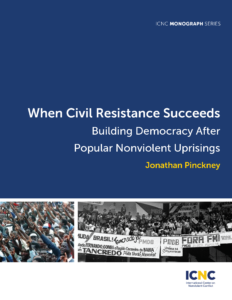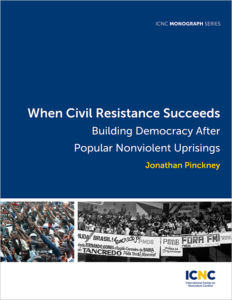Join us for a public presentation and panel discussion:
Civil Resistance and Democratization:
Building Democracy after Popular Nonviolent Uprisings
An ICNC Monograph
Wednesday, October 10, 2018
10-11:30am EDT
U.S. Institute of Peace
2301 Constitution Avenue, NW
Washington, DC 20037
RSVP NOW
 A groundbreaking new ICNC monograph by Jonathan Pinckney (downloadable here) demonstrates that nonviolent movements make democratic transitions more likely and lead to stronger democracies. Drawing from decades of data, refined statistical analysis and in-depth case studies, the monograph identifies the role of civil resistance in maximizing democratic consolidation and addresses why some nonviolent revolutions lead to successful democratization and others do not. It further shares insights about what activists and their allies, including members of the policy community, can do to increase the odds of successful democratic consolidation.
A groundbreaking new ICNC monograph by Jonathan Pinckney (downloadable here) demonstrates that nonviolent movements make democratic transitions more likely and lead to stronger democracies. Drawing from decades of data, refined statistical analysis and in-depth case studies, the monograph identifies the role of civil resistance in maximizing democratic consolidation and addresses why some nonviolent revolutions lead to successful democratization and others do not. It further shares insights about what activists and their allies, including members of the policy community, can do to increase the odds of successful democratic consolidation.
Join ICNC and the U.S. Institute of Peace for a presentation by Dr. Pinckney followed by a panel discussion. The event will provide key takeaways for activists, organizers, scholars, and people interested in supporting nonviolent movements, particularly prior to and during democratic transitions.
RSVP NOW
Featured Speakers
 Dr. Jonathan Pinckney, author
Dr. Jonathan Pinckney, author
Research Fellow, International Center on Nonviolent Conflict; Post-Doctoral Research Fellow, Norwegian University of Technology and Science; and External Associate, Peace Research Institute of Oslo
 Dr. Maciej Bartkowski, moderator
Dr. Maciej Bartkowski, moderator
Senior Director, Education and Research, International Center on Nonviolent Conflict
 Dr. Maria Stephan
Dr. Maria Stephan
Director, Program on Nonviolent Action, United States Institute of Peace
 Dr. Nancy Okail
Dr. Nancy Okail
Executive Director, The Tahrir Institute for Middle East Policy
 Melinda Haring
Melinda Haring
Editor, UkraineAlert blog at the Atlantic Council and fellow, Foreign Policy Research Institute
About the Monograph
 Abstract: Why do nonviolent movements often lead to democracy? Why do they sometimes not? While several existing studies have pointed to a strong connection between successful campaigns of civil resistance and a greater likelihood of democratization, prominent failures of democratization, as in many of the Arab Spring cases, raise questions about this finding. Furthermore, little literature has examined the dynamics of civil resistance campaigns following the initial democratic breakthrough to trace the mechanisms whereby civil resistance can encourage or undermine democratic prospects. In When Civil Resistance Succeeds: Building Democracy After Popular Nonviolent Uprisings, the author presents a theory of civil resistance transitions, focusing on a series of strategic challenges faced by nonviolent movements after their initial democratic breakthrough. The monograph argues that resolving three challenges: transitional mobilization, the problem of leftovers, and depolarization, is crucial for a successful transition to democracy. The monograph supports this argument with a quantitative analysis of all transitions from authoritarianism initiated by civil resistance from 1945-2011 and several qualitative case studies.
Abstract: Why do nonviolent movements often lead to democracy? Why do they sometimes not? While several existing studies have pointed to a strong connection between successful campaigns of civil resistance and a greater likelihood of democratization, prominent failures of democratization, as in many of the Arab Spring cases, raise questions about this finding. Furthermore, little literature has examined the dynamics of civil resistance campaigns following the initial democratic breakthrough to trace the mechanisms whereby civil resistance can encourage or undermine democratic prospects. In When Civil Resistance Succeeds: Building Democracy After Popular Nonviolent Uprisings, the author presents a theory of civil resistance transitions, focusing on a series of strategic challenges faced by nonviolent movements after their initial democratic breakthrough. The monograph argues that resolving three challenges: transitional mobilization, the problem of leftovers, and depolarization, is crucial for a successful transition to democracy. The monograph supports this argument with a quantitative analysis of all transitions from authoritarianism initiated by civil resistance from 1945-2011 and several qualitative case studies.
